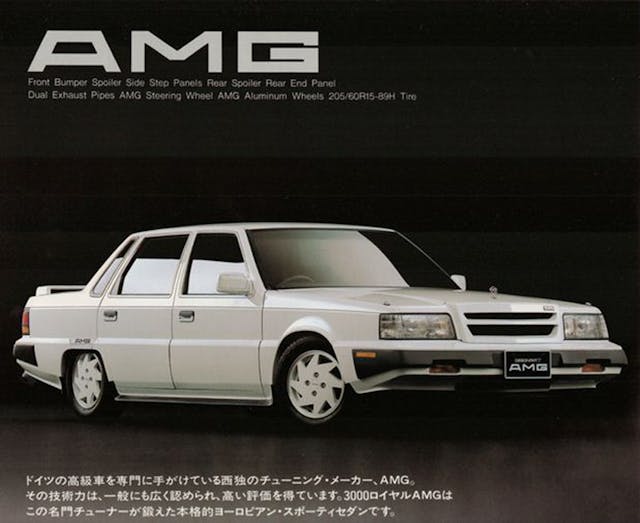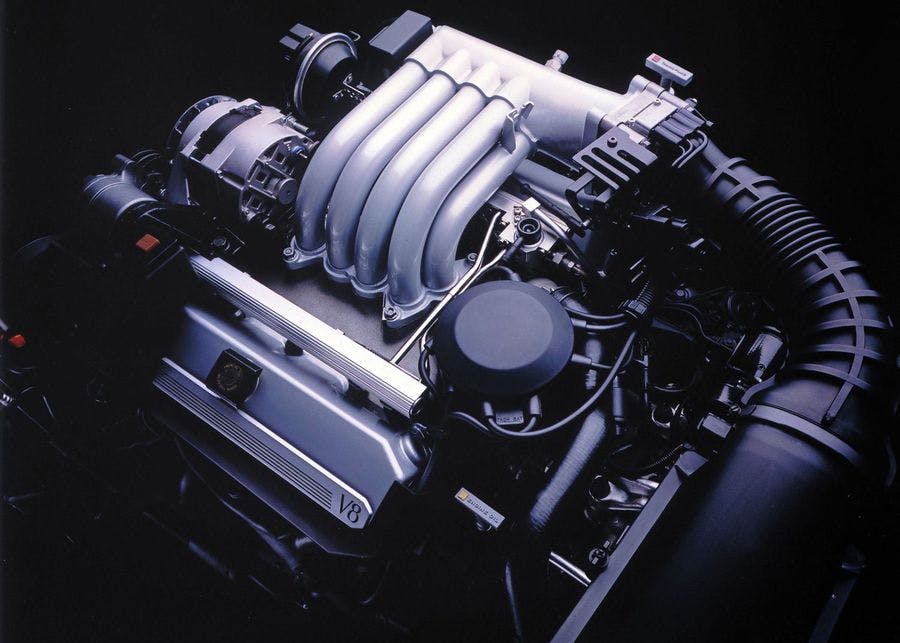Media | Articles
When AMG (Almost) Went American
Aufrecht, Melcher, and Großaspach — better known as AMG—has a long and distinguished history as the in-house hot rod shop at Mercedes-Benz. Before it officially became a part of the Daimler empire, however, AMG was a private shop founded by the three Mercedes-Benz engineers whose last names form its famous initials. From the late 1960s until the late ’90s, AMG operated independently of, although often in partnership with, the Silver Star on the production of race cars and street machines alike.

This meant that for its first several decades of existence, AMG was effectively a free agent, and able to strike deals with as many different automakers as it desired in the quest to boost its bottom line and keep building interesting cars. In some cases this meant forging alliances that have largely been forgotten, such as AMG’s partnership with Mitsubishi, a team-up based on mutual engineering admiration.

In others, it led the company down more winding roads that didn’t necessarily end at the desired destination. At least, that’s what happened when AMG attempted to court Detroit by way of America’s most prestigious badge—Cadillac—after a brief flirtation with perpetually second-place Lincoln. It’s a “what-might-have-been” that had the potential to rewrite an entire decade of luxury performance cars, done in by the familiar bean counter curse that dogged General Motors during a particularly dark financial period.
Cadillac’s Attempted Turnaround Seeks Some Euro Spice

Cadillac was in a bit of a weird position at the end of the 1980s. With a line-up still weighed down by formal full-size sedans that made their tonnage a point of pride, and struggling to make the hand-assembled, Italian-bodied Allante profitable, it was difficult to spot anything sporty in the automaker’s showroom. Even the zippiest of Caddies—the Seville sedan, the Eldorado coupe, and the aforementioned Allante convertible—were all sub-200 horsepower machines that sent their output to the front wheels, making them relatively weak rivals for the hotter metal pouring out of Germany from BMW and Mercedes-Benz.

Help was on the way—eventually—in the form of the Northstar, a bespoke V-8 engine that was initially exclusive to the Cadillac brand. Slated for the company’s front-pullers, it planned to put 300 horses to the pavement via an all-new platform and erase the memories of lackluster eight-cylinder engines like the 4.1-liter and 4.5-liter “High Technology” series.
In the lead up to the line-up’s glow-up, however, there were some at Cadillac who felt that to truly do battle with the European competition, it might be necessary to tag in a third party who’d had significant success in the same department. Specifically, the decision was made to approach AMG about tweaking the upcoming Seville redesign as a prelude to its eventual makeover.
Marketplace
Buy and sell classics with confidence
Teaching Caddies How To Zig
“AMG and Cadillac, we had meetings with Bob Dorn who was the head of engineering, along with a team of four others [to discuss the Seville project,] says Richard Buxbaum, founder and chief of AMG’s American operations prior to its merger with Daimler. “I made several trips to Detroit to visit the engineering department, and they hired us. At that point, Cadillac sent a Seville or two to AMG Germany.”
Buxbaum relates that these were far from casual conversations. AMG hosted a group of Cadillac engineers at the Transportation Research Center, the massive high-speed testing oval located in Ohio that is now owned by Honda. The group was familiarized with AMG models, specifically their handling and drivetrain capabilities, which was only one component of the extensive period of time the two companies spent together in collaboration.

“[Hans Werner] Aufrecht was here with us,” says Buxbaum. “He met with Cadillac, face-to-face. Things were moving along well. Dick Ruzzin, who was in charge of exteriors at the time for Cadillac, he designed the next Seville body so that the bumpers could come off easily and accept AMG body parts. It progressed to the point where we had a deal made.”
There were concerns, of course, about Cadillac’s existing platforms. Buxbaum explains that a set of AMG aero wheels were machined for the Seville to see how they’d look on the car, but that he’d also been told by Dorn that, at the time, 200 horsepower was the maximum the company could reliably push through their existing front-wheel drive setup.
“That was kind of the crux,” says Buxbaum. “I said to him, ‘If you can’t make it all-wheel drive or rear-wheel drive, this isn’t going to work.”
Throttled By Finance

Cadillac broke through their 200 horsepower barrier with the arrival of the Northstar, but as it turns out, there were more intractable forces aimed at scuttling the planned partnership. Once the holders of GM’s purse strings got word of the AMG/Cadillac tie-up, a hasty cost analysis determined that spending the money on a sporty, Euro-flavored Seville simply wasn’t in the budgetary cards. The deal was nixed, and the two companies parted ways.
At the same time as the Cadillac partnership was being negotiated, there were hints that AMG might be looking to make its Detroit deal a twofer. A report in AutoWeek from late 1986 alludes to a potential AMG package for Lincoln’s upcoming Mark VII personal luxury coupe refresh, with a quote from AMG employee Chris Schwingle indicating that a potential body kit and suspension package was in the works for the model.

Filtering that report through four decades of distance, it turns out there was never any substance to those rumors. “Mark Stehrenberger [the celebrated automotive designer] did some drawings for us of the car,” but it never went any further than that, according to Buxbaum. Still, the AutoWeek piece claims that on top of the renderings there was a SEMA car built and then “sold to an Indiana dealer,” with a photo of the supposed prototype included by the publication. If anyone has ever come across this car, don’t hesitate to reach out and let us know.
A Pre-SUV Sports Coupe Renaissance, Thwarted
All of the above reads like an alluring roadmap for an alternate automotive future, replete with high-end 1980s American performance cars. It’s dizzying to imagine the heights that AMG could have reached had they been given access to either Ford or GM’s trove of eight-cylinder engines. If customers could be tempted to spend import money on home-grown speed, who knows how much power could have been unlocked thanks to AMG’s engineering focus?

There’s no doubt that the next-generation Cadillac Seville did much to improve the brand’s fortunes after flailing in the wilderness for so many years, but as with the also-excellent Lincoln Mark VIII follow-up, more power and sleeker styling wasn’t enough to stave off the SUV encroachment that wiped personal luxury from the map by the end of the 1990s. Still, we’d like to think that an AMG badge on either trunk lid might have been enough to buy us a few more good years of tire-smoking fun.












I still love the Lincoln MK VII myself over the equivalent Cadillac of the day.
I chose the Mark VIII as my dear wife loved the styling and the mechanicals definitely were up to spec for me. I was tempted a few years later to get her an STS with rear drive, but ultimately she preferred the familiar one. She says it is her “cockpit” and we still drive it occasionally. Amazing how well it has aged, especially as I have aged very poorly.
I felt my 1996 STS was one of the nicest four door sedan ever, I finally gave it to my grandson for his birthday. It had over 200,000 miles on it and all I ever did to the Northstar engine was change the water pump and spark plugs.